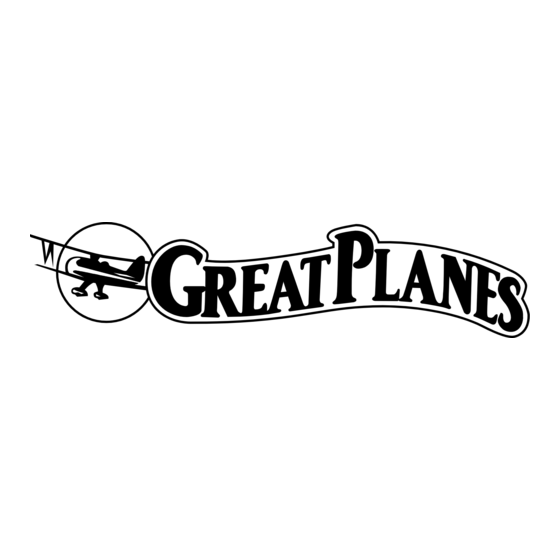GREAT PLANES Riot 3D Instruction Manual - Page 15
Browse online or download pdf Instruction Manual for Toy GREAT PLANES Riot 3D. GREAT PLANES Riot 3D 20 pages.

❏
1. Use a felt-tip pen or 1/8" [3.2mm]-wide tape to accurately
mark the C.G. on the bottom of the top wing near each wing
tip. The C.G. is located 2-5/16" [58mm] back from the
leading edge of the top wing.
This is where your model should balance for the first
flights. Later, you may wish to experiment by shifting the
C.G. up to 0.4" [10mm] forward or back to change the
flying characteristics. Moving the C.G. forward may
improve the smoothness and stability, but the model may
then require more speed for takeoff and make it more
difficult to slow for landing. Moving the C.G. aft makes the
model more maneuverable, but could also cause it to
become too difficult to control. In any case, start at the
recommended balance point and do not at any time
balance the model outside the specified range.
❏
2. With all parts of the model installed (ready to fly) and
battery installed, lift the model right-side up at the balance
point you marked.
❏
3. If the tail drops, the model is "tail heavy" and the battery
pack and/or receiver must be shifted forward or weight must be
added to the nose to balance. If the nose drops, the model is
"nose heavy" and the battery pack and/or receiver must be
shifted aft or weight must be added to the tail to balance. If
possible, relocate the battery pack and receiver to minimize or
eliminate any additional ballast required. Use Great Planes
(GPMQ4485) "stick-on" lead to add additional weight to the
Riot 3D ARF if needed. A good place to add stick-on nose
weight is to the bottom of the fuselage under the firewall. Begin
by placing incrementally increasing amounts of weight on the
bottom of the fuse over the firewall until the model balances.
Once you have determined the amount of weight required, it
can be permanently attached. If required, tail weight may be
added by cutting open the bottom of the fuse and gluing it
permanently inside. DO NOT attach tail weight to the stab, as
it is not intended to support additional weight.
❏
4. IMPORTANT: If you found it necessary to add any
weight, recheck the C.G. after the weight has been installed.
Balance the Model Laterally
❏
1. With the wing level, have an assistant help you lift the
model by the engine propeller shaft and the bottom of the
fuse under the TE of the fin. Do this several times.
❏
2. If one wing always drops when you lift the model, it
means that side is heavy. Balance the airplane by adding
weight to the other wing tip. An airplane that has been laterally
balanced will track better in loops and other maneuvers.
PREFLIGHT
Identify Your Model
No matter if you fly at an AMA sanctioned R/C club site or if
you fly somewhere on your own, you should always have
your name, address, telephone number and AMA number
on or inside your model. It is required at all AMA R/C club
flying sites and AMA sanctioned flying events. Fill out the
identification tag on page 18 of this manual and place it on
or inside your model.
Charge the Batteries
Follow the battery charging instructions that came with your
radio control system to charge the batteries. You should
always charge your transmitter and receiver batteries the
night before you go flying, and at other times as
recommended by the radio manufacturer.
CAUTION: Unless the instructions that came with your
radio system state differently, the initial charge on new
transmitter and receiver batteries should be done for 15
hours using the slow-charger that came with the radio
system. This will "condition" the batteries so that the next
charge may be done using the fast-charger of your choice.
If the initial charge is done with a fast-charger, the
batteries may not reach their full capacity and you may be
flying with batteries that are only partially charged.
15
